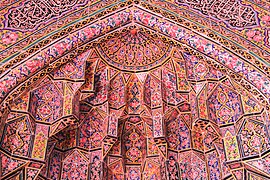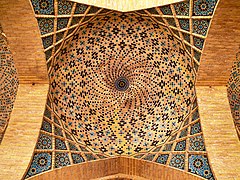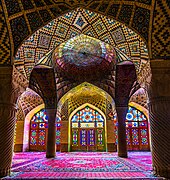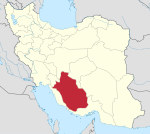Nasir-ol-Molk Mosque
 From Wikipedia the free encyclopedia
From Wikipedia the free encyclopedia
You can help expand this article with text translated from the corresponding article in Persian. (May 2022) Click [show] for important translation instructions.
|
| Nasir al-Mulk Mosque | |
|---|---|
 | |
| Religion | |
| Affiliation | Shia Islam |
| Province | Fars Province |
| Status | Active |
| Location | |
| Location | Shiraz, Iran |
| Municipality | Shiraz County |
| Geographic coordinates | 29°36′31″N 52°32′54″E / 29.60861°N 52.54833°E |
| Architecture | |
| Type | Mosque |
| Style | Islamic, Iranian architecture |
| Completed | 1888 |
| Website | |
| http://www.nasirolmolkmosque.com/ | |
The Nasir al-Mulk Mosque (Persian: مسجد نصیرالملک, Masjed-e Nasir ol-Molk), also known as the Pink Mosque (مسجد صورتی, Masjed-e Surati), is a traditional mosque in Shiraz, Iran. It is located near Shāh Chérāgh Mosque. It was built during Qajar dynasty rule of Iran.
The mosque includes extensive coloured glass in its facade, and displays other traditional elements such as the Panj Kāse ("five concaved") design.[1]

History
[edit]The mosque was built during the Qajar dynasty, and is still in use under protection by the Endowment Foundation of Nasir al Molk. Construction began in 1876 by the order of Mirza Hassan Ali Nasir-ol-Mulk, one of the lords and aristocrats of Shiraz, the son of Ali Akbar Qavam al-Mulk, the kalantar of Shiraz and was completed in 1888. The designers were Mohammad Hasan-e-Memār, a Persian architect who had also built the noted Eram Garden before the Nasir al-Molk Mosque, Mohammad Hosseini Shirazi, and Mohammad Rezā Kāshi-Sāz-e-Širāzi.[2]
Orsi: Persian Stained Glass
[edit]
Although stained glass is mostly popular in churches nowadays, the earliest discovered was in Syria from the 7th century.[dubious – discuss] There is evidence of techniques and recipes for obtaining stained glass by the Persian chemist Jabir ibn Hayyan in his book Kitab al-Durra al-maknuna (The Book of the Hidden Pearl) published in the eighth century CE.[3] Orsi windows are windows made of a mixture of wood and colorful glass in the Safavid and the Qajar dynasties. Orsi differs from stained glass used in many churches and Ottoman mosques which serve as illuminated images rather than a source of light. Light is a major feature in many mosques considering it being a major symbol of God in Islam. This is mentioned in a chapter in Quran:
″Allah is the light of the heavens and the earth″[4]
Gallery
[edit]- Winter prayer hall
- Winter prayer hall
- Outside of the mosque
- Outside of the mosque at night
- Muqarnas of Nasir-ol-molk Mosque
- Ceilings of the winter prayer hall
- Decoration of the mosque
- Mosaic dome interior
- interior


See also
[edit]References
[edit]- ^ Cem Nizamoglu. "Mosque of Whirling Colours: A Mixture of Architecture and Art in Nasīr al-Mulk Mosque in Shiraz, Iran". MuslimHeritage.com. Archived from the original on 11 May 2016.
- ^ “A Mixture of Architecture and Art in Nasir Al-Mulk Mosque in Shiraz, Iran.” Nasir Al-Mulk Mosque, http://nasiralmulk.ir/.
- ^ Al-Hassan, Ahmad Y. “AN EIGHTH CENTURY ARABIC TREATISE ON THE COLOURING OF GLASS: KITĀB AL-DURRA AL-MAKNŪNA (THE BOOK OF THE HIDDEN PEARL) OF JĀBIR IBN ḤAYYĀN (c. 721–c. 815).” Arabic Sciences and Philosophy, vol. 19, no. 1, 2009, pp. 121–156.
- ^ The Qur'an [24:35]
External links
[edit]- Nasir ol Molk Mosque on Art-Days.com
- Nasir ol Molk Mosque on Albert-Videt.eu (in French)
- BBC Persian: Nasir ol Molk (in Persian)
























